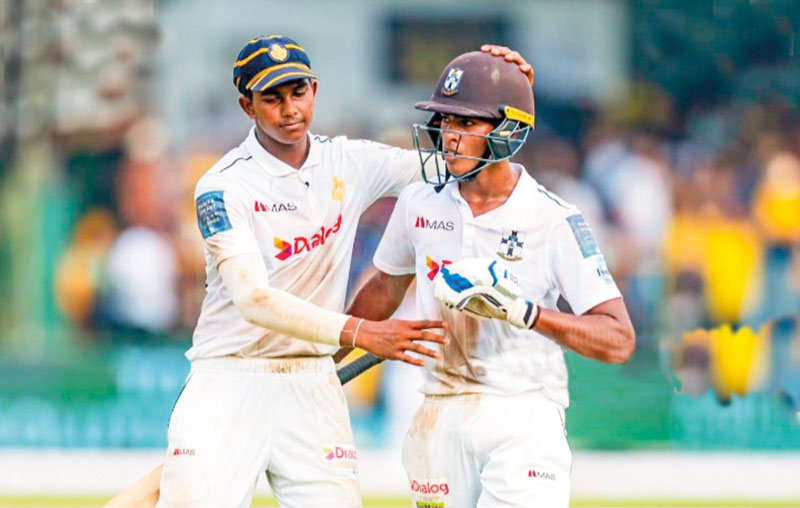By Anura Gunasekera Big matches come and go; today they are numerous but the Royal-Thomian, the first of its kind in this country, stands apart as an eternal metaphor for tradition, style, charm, excitement and unpredictability. No other sporting encounter in the country, not even an international event, generates the passionate rivalry, the limitless appeal, the widespread social enthusiasm, the Bacchic revelry or the fervent anticipation, as does the battle between these two tribes. This writer does not mean any offence to other schools or to other sporting encounters, but does not see the need to entertain a dissenting view.
The match ceased to be a mere sporting event many decades ago. It has become a microcosm of the passage of life, mirroring the broader human experience. Over the decades it has shaped a generational continuity, with a new group stepping in to continue the tradition, an honoured legacy, as one generation exits.

It fosters growth and change, whilst remaining anchored to a revered tradition rooted, albeit, in a colonial past. As much as individuals inherit legacies, values and expectations from their families and communities, the match has fostered a tradition which has remained a constant for one-and-a-half centuries. The fact that its original spirit is still very much alive, despite the social and national changes which have evolved around it, and that its founding concept has been embraced and emulated by so many other schools, is testament to its relevance to life today, notwithstanding its antiquity, and its genesis in a British-imposed elitism and exclusivity- the latter an accusation frequently levelled against the event and the institutions which generate it.
The Sri Lanka of today is unrecognizably different from the colonial Ceylon which birthed the Royal-Thomian, but that encounter remains the same, as it was 146 years ago. The actors, the locations , the institutions and the scope of the event have changed, but the founding spirit is untouched. This iconic encounter has come to symbolize healthy competition, nourishing rivalry, the value of determination, preparation and team-work and the will-to-win, but all within an inviolable framework of fair play and sportsmanship.
It respects history whilst enriching it with each successive encounter, finding ways, through exceptional individual and team performances , to contribute to and enhance an ongoing fable. It fosters a sense of belonging and pride, not just for individuals but for the larger community. It is no longer the exclusive property of the Royal-Thomian tribesmen but has embraced a massive extended family of supporters, aficionados, enthusiasts and well-wishers.
It has become an inclusive feast. The encounter teaches that despite differences and challenges, unity and collaboration from both competing parties are essential for success and growth. As in life, for both teams there is immense pressure to perform and to succeed in what is a high-stakes encounter, to meet the expectations of a society which has grown around it, and formed special identities linked to the competition- family, school, culture and country.
The match, in essence, is a cauldron which shapes triumph and failure, the joy of victory and the anguish of defeat, and the ability to accept both with grace and equanimity, coupled with the determination to make amends at the next encounter. It reflects the eternal truths of the human experience, that life is not always kind, that nature is not always fair, that despite your best efforts the other side will sometimes do better, even if it is not the best equipped or the more fancied. To use a highly over-used cliché, ” the race is not always to the swift”, and cricket proves it time and time again.
The 146th edition of this celebrated encounter reflected, in a multitude of ways, all the contradictions and commonalities described above. STC, after winning the toss, sent Royal, the pre-match favourites, in to bat, on what appeared to be a typically friendly and placid SSC wicket. After an initial stutter which seemed to justify a risky decision by STC, Royal settled down and went on to post an imposing 319/7.
Rehan Pieris crafted a majestic 158, watched reflectively, from the comfort of the “Mustangs” enclosure, by Ronald Reid, a batting genius of a different era, who compiled the identical score for STC in 1956. In doing so he erased the previous Royal-Thomian batting record of 151 by Norman Siebel of STC, established in 1936. The writer, who, as a ten year old Thomian watched the Reid enterprise, can now claim the privilege of having seen two brilliant performances, separated from each other by a distance of 69 years; the quality in both so similar, despite the first being an elegant left-hander and the recent edition from an aggressive right-hander, that it was like being in a time-warp.
STC, undeterred by the mountain of runs confronting them, produced a decent response of their own. Dineth Goonewardene, with an excellent century- the first by a Thomian since 2016- scored at a brisk rate, made a major contribution. Royal, in their second essay , seemed very much in control with all features pointing to a comfortable draw, when the unpredictability of cricket reared its menacing head; out of the humid and burning-hot ether, Darien Diego, bowling a steady, but unthreatening line and length all afternoon, suddenly produced the feared hat-trick; according to statisticians only the third by a Thomian in the history of the series.
Royal, perhaps compelled, and perhaps slightly befuddled, by the unexpected reversal of fortune, made what was a challenging but sporting declaration, throwing down the gauntlet, as it were. The target of 233 in 42 overs was daunting but given some measured adventurism, not unattainable. STC did exactly that, achieving it with an over to spare.
Jaden Amaraweera and Mithila Charles provided early stability at the top with calculated but quick accumulation and Sadev Soysa, in the middle, with a short but fiery knock, reduced a demanding run-rate to manageable proportions. One outstanding feature of the Thomian victory was the nerveless batting of 15 year old newcomer, Reshon Solomon, a somewhat disputed inclusion in the team, at the expense of coloursman Abeeth Paranawidana. Solomon, despite having had only two previous outings and both in friendly matches, justified his selection for the big stage with a brilliant half-century, scored alongside the first innings centurion, Goonewardane, matching the latter shot-for-shot.
The pair batted with such composure that a seemingly elusive target soon became a certainty. Irrespective of the reasons which prompted it, the early declaration by Royal made a decision possible. One must not forget that losing three batsmen in three deliveries and with two wickets left, they could have, quite justifiably, opted for the safer option of batting till the end and closing down the game.
Royal obviously declared with a different result in mind but cricket is capricious, which is also a feature of its allure. This writer first attended the Royal-Thomian in 1955, and has witnessed all the matches since, barring a brief hiatus in the early 19-seventies. Memories of individual matches, however exciting, are now vague though, the details lost in the fog of excessive merriment, generated in exclusive but boisterous enclosures like the “Colts”, “Stallions” and, latterly, the more sedate “Mustangs”.
However, one Thomian victory which still remains indelible in memory is that of 1964, when STC, under the late Premalal Goonesekera, clinched victory in a nail-biting finish, providing a decision after ten consecutive drawn matches ( ’54-’63). That match is also remembered for Sarath Seneviratne’s brilliant 96, breaking Thomian hearts by falling short of a century, a tragedy he re-enacted in the very next Royal-Thomian as well, losing his wicket at 97. In a parody of fame, Sarath is recalled more often by Thomians for the centuries that he failed to score, than are other batsmen who actually did.
The 2025 Thomian victory too will similarly remain in the writer’s memory, for the much shorter lease of life now left to him. But more than the Thomian win, which will eventually become a statistic, the unforgettable feature of the game was the generous spirit, the fierce but fair competition, and the genuine respect which the competitors displayed towards each other. Those are life-lessons, far more important than the end-result, for all to take away, emulate and cherish.
.
Top

The Royal-Thomian and its Timeless Charm

By Anura Gunasekera Big matches come and go; today they are numerous but the Royal-Thomian, the first of its kind in this country, stands apart as an eternal metaphor for tradition, style, charm, excitement and unpredictability. No other sporting encounter in the country, not even an international event, generates the passionate rivalry, the limitless appeal, [...]











